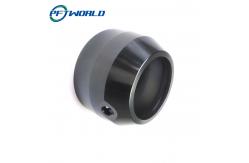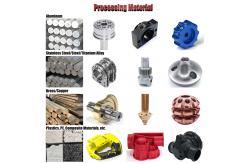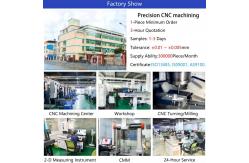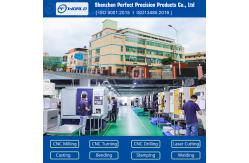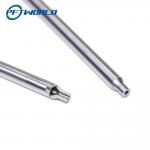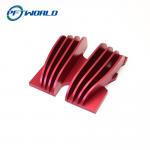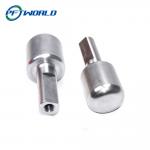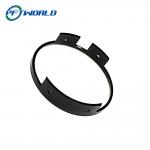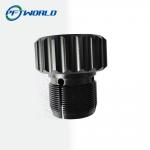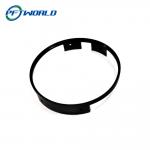|
 
The Process of OEM Aluminum Precision Turning and Milling Composite Parts
Precision turning and milling are advanced CNC (Computer Numerical Control) machining processes that allow for the creation of highly accurate, repeatable parts. Let’s take a closer look at how these processes work when applied to aluminum composite parts:
1.CNC Turning
CNC turning is a subtractive manufacturing process where a rotating aluminum workpiece is cut using a stationary tool to create the desired shape. In precision CNC turning, the process focuses on producing cylindrical or rounded components with exacting dimensions, making it ideal for parts like shafts, bushings, rings, and other rotationally symmetric components.
- Key Benefits: High accuracy, excellent surface finish, and the ability to produce parts with tight tolerances.
- Applications: Engine components, fasteners, gears, fittings, and seals.
2.CNC Milling
CNC milling involves using a rotating tool to remove material from a fixed aluminum workpiece. This process is typically used to create parts with complex geometries, multiple surfaces, and detailed features like pockets, slots, holes, and other intricate designs. The versatility of CNC milling allows for the production of both simple and complex composite parts in a variety of shapes and sizes.
- Key Benefits: Capability to produce complex shapes, intricate detailing, and high precision.
- Applications: Structural components, brackets, housings, and custom parts for aerospace, automotive, and industrial applications.
3.Composite Materials
When combined with composite materials, aluminum CNC turning and milling processes can produce parts that exhibit both the lightweight properties of aluminum and the enhanced strength, flexibility, and wear resistance of composite materials. Commonly used composites include carbon fiber, fiberglass, and polymer blends, which can be integrated into aluminum components to achieve superior mechanical performance.
- Benefits of Composite Materials: Improved strength-to-weight ratio, enhanced durability, and resistance to fatigue.
- Applications: Parts used in the automotive, aerospace, and sporting goods industries, where the combination of aluminum’s light weight and composites’ strength is particularly beneficial.
Industries That Benefit from OEM Aluminum Precision Turning and Milling Composite Parts
1.Aerospace
In the aerospace industry, where weight reduction and part durability are critical, OEM aluminum precision turning and milling composite parts are used for everything from structural components to engine parts and high-performance components for avionics. With CNC machining, manufacturers can produce parts with precise tolerances that ensure optimal performance and safety in high-pressure, high-stress environments.
2.Automotive
The automotive industry is another sector where lightweight yet durable parts are essential. Whether it’s for electric vehicles (EVs), internal combustion engine (ICE) vehicles, or high-performance racing cars, aluminum composite parts help manufacturers meet weight, safety, and performance targets.
3.Medical Devices
OEM aluminum precision turning and milling composite parts are widely used in medical device manufacturing, where high precision, strength, and biocompatibility are essential. Aluminum’s corrosion resistance combined with composite materials ensures long-lasting, lightweight parts for critical applications such as surgical tools and implants.
4.Industrial Equipment
Industrial applications often require heavy-duty components that must endure extreme environments. OEM aluminum composite parts produced through CNC turning and milling provide reliable, long-lasting solutions for industries such as construction, manufacturing, and energy.
5.Consumer Electronics
With an increasing demand for lightweight and durable consumer electronics, aluminum composite parts are used in the manufacturing of housings, enclosures, and structural supports for electronic devices like laptops, smartphones, and wearables.
Conclusion OEM aluminum precision turning and milling composite parts offer unparalleled advantages when it comes to performance, precision, and versatility. By leveraging the latest CNC machining technologies, manufacturers can produce custom parts that meet the strictest requirements of industries like aerospace, automotive, medical devices, and industrial manufacturing. The combination of aluminum’s light weight and durability with composite materials’ enhanced strength properties makes these parts ideal for high-performance applications. | | CNC Turning, CNC Milling, Laser Cutting, Bending, Spining, Wire Cutting, Stamping, Electric Discharge Machining (EDM), Injection Molding,3D Printing,Rapid Prototype,Moulds etc. | | | Aluminum: 2000 series, 6000 series, 7075, 5052, etc. | | Stainlesss steel: SUS303, SUS304, SS316, SS316L, 17-4PH, etc. | | Steel: 1214L/1215/1045/4140/SCM440/40CrMo, etc. | | Brass: 260, C360, H59, H60, H62, H63, H65, H68, H70, Bronze, Copper | | Titanium: Grade F1-F5 | | Plastic: Acetal/POM/PA/Nylon/PC/PMMA/PVC/PU/Acrylic/ABS/PTFE/PEEK etc. | | | Anodized, Bead Blasted, Silk Screen, PVD Plating, Zinc/Nickl/Chrome/Titanium Plating, Brushing, Painting, Powder Coated, Passivation, Electrophoresis, Electro Polishing, Knurl, Laser/Etch/Engrave etc. | | | ±0.002 ~ ±0.005mm | | | Min Ra 0.1~3.2 | | CERTIFICATE | ISO9001:2015,AS9100D,ISO13485:2016,ISO45001:2018,IATF16949:2016,ISO14001:2015,ROSH,CE etc. | 




FAQ 1. Are you a manufacturer or a trading company? We are a factory located in Shenzhen, China, with 20 years of rich experience,
covering 6000 square meters. Complete facilities, including 3D quality inspection equipment, ERP system and 40 machines. If necessary, we can provide you with material certificates, sample quality inspection and other reports. 2. How to get a quote?
Detailed drawings (PDF/STEP/IGS/DWG...), including quality, delivery date, materials, quality, quantity, surface treatment and other information. 3. Can I get a quotation without drawings? Can your engineering team draw for my creativity? Of course, we are also glad to receive your samples, pictures or detailed size drafts for accurate quotation. 4. Can you provide samples before mass production? Of course, the sample fee is necessary. If possible, it will be returned during mass production. 5. What is the delivery date? Generally, the sample lasts for 1-2 weeks and the batch production lasts for 3-4 weeks. 6. How do you control quality? (1) Material Inspection - Check material surfaces and approximate dimensions. (2) First inspection of production - ensure critical dimensions in mass production. (3) Sampling inspection - check the quality before delivery to the warehouse. (4) Preshipment inspection - 100% inspection by QC assistant before shipment. 7. After sales service team If you have any problems after receiving the product, you can provide feedback through voice call, video conference, email, etc. within one month. Our team will provide you with solutions within a week. |

